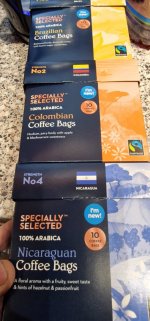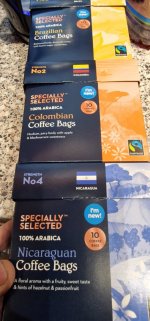wildebus
Full Member
- Messages
- 7,737
I know how to make coffee is a popular topic so I thought out of curiosity I would try an experiment 
Exhibit 1: The Bosch Tassimo
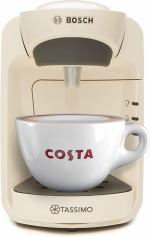
This is an inexpensive coffee machine and in terms of electric capsule coffee makers one of the cheapest and lowest powered ones at £30 and 1300W. The Power aspect is important when thinking Motorhome compatibility.
Exhibit 2: A Inverter. In my case, a Victron Multiplus 12/1600/70. The 12/1600 Multiplus is actually a 1300 Watt Inverter (the '1600' number refers to VA - Volt-Amps, which is not the same as Watts, despite the popular equation Watts = Volts x Amps, but that is another discussion).
So first hurdle ... Maximum continuous power of Inverter - 1300W- is no greater than the power Coffee machine demands - 1300W. Could be an issue?
Let's see what happens ...
Well, firstly, I can confirm I got a cup of Jacobs Cappachino out of the Tassimo off-grid, so that is a tick in the box. But what happened to the Multiplus and Battery Bank to provide it?
To note a point before showing graphs .... The Victron VRM system only samples the data (voltage, current, etc) once a minute. The coffee machine only runs for a couple of minutes so key points may not show up
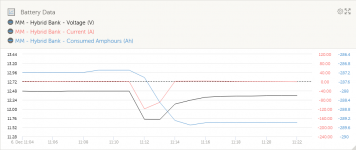
The amount of Battery taken to make a cup of coffee was pretty small in the scheme of things - before it started, had 287.1Ah taken out the battery. After it had finished had 289.4Ah out the battery - so just 2.3Ah to make a cup of coffee. That is under 30Wh (typical 100Ah Lead battery is 1200Wh).
There was a significant drop in voltage due to the load - from 12.48V right down to 11.72V
According to the sampled data, the current peaked at 120A. At 120A with a voltage of 11.72V, that is over 1400W (I know I am back using P=V*A here!) so beyond the rating of the inverter and also higher than the quoted machine draw, which is interesting (and surprising).
This gets a touch more interesting with what I saw when looking at the Victron BMV, which showed during the time the machine was running, a current peak of 172A! That is a massive power draw of over 2000W for a supposed 1300W device and also to be delivered by a 1300W Inverter.
Unsurprisingly, The inverter reported an overload condition and also a low voltage condition (if the voltage dropped to 11.72V on a 120A current, it will have dropped a fair bit more on the 172A draw)
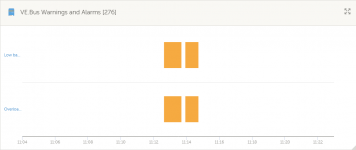
The reason there are two sets of overload and low voltage is the machine has to run twice - once for the milk for the cappachino and once for the coffee.
The Multiplus was still able to run the machine even at the overloaded power rating as it has a peak power of 3000W it can provide for 30 seconds, but it was clear that it didn't appreciate the load from the noises it made as the coffee machine did its pulsing.
Conclusions:
I don't think I will be taking the Tassimo away in the Motorhome unless I know I will be heading to locations where I will be plugging into EHU. Given that I have setup the battery bank so that is not needed, that EHU provision is unlikely on any regular basis. I don't actually have any issue with instant coffee TBH, but as I got one of these for the OH for Christmas (she doesn't know yet!) as well as a big selection of drinks, getting a second one for potentially the Motorhome seemed a reasonable plan given they are inexpensive machines.
After seeing the current draw from this apparent 1300W Machine, I would be wary of using it - or any other coffee machine on Inverters lower than 2000W as a minimum I think. The Victron Inverters over-rating capabilities in general have always been impressive and can cope either reluctantly or by shutting down, but other inverters could well get damaged. I think I will put a watt-meter on the Tassimo when I next run it on the Mains and see what power and currents are recorded
Exhibit 1: The Bosch Tassimo

This is an inexpensive coffee machine and in terms of electric capsule coffee makers one of the cheapest and lowest powered ones at £30 and 1300W. The Power aspect is important when thinking Motorhome compatibility.
Exhibit 2: A Inverter. In my case, a Victron Multiplus 12/1600/70. The 12/1600 Multiplus is actually a 1300 Watt Inverter (the '1600' number refers to VA - Volt-Amps, which is not the same as Watts, despite the popular equation Watts = Volts x Amps, but that is another discussion).
So first hurdle ... Maximum continuous power of Inverter - 1300W- is no greater than the power Coffee machine demands - 1300W. Could be an issue?
Let's see what happens ...
Well, firstly, I can confirm I got a cup of Jacobs Cappachino out of the Tassimo off-grid, so that is a tick in the box. But what happened to the Multiplus and Battery Bank to provide it?
To note a point before showing graphs .... The Victron VRM system only samples the data (voltage, current, etc) once a minute. The coffee machine only runs for a couple of minutes so key points may not show up

The amount of Battery taken to make a cup of coffee was pretty small in the scheme of things - before it started, had 287.1Ah taken out the battery. After it had finished had 289.4Ah out the battery - so just 2.3Ah to make a cup of coffee. That is under 30Wh (typical 100Ah Lead battery is 1200Wh).
There was a significant drop in voltage due to the load - from 12.48V right down to 11.72V
According to the sampled data, the current peaked at 120A. At 120A with a voltage of 11.72V, that is over 1400W (I know I am back using P=V*A here!) so beyond the rating of the inverter and also higher than the quoted machine draw, which is interesting (and surprising).
This gets a touch more interesting with what I saw when looking at the Victron BMV, which showed during the time the machine was running, a current peak of 172A! That is a massive power draw of over 2000W for a supposed 1300W device and also to be delivered by a 1300W Inverter.
Unsurprisingly, The inverter reported an overload condition and also a low voltage condition (if the voltage dropped to 11.72V on a 120A current, it will have dropped a fair bit more on the 172A draw)

The reason there are two sets of overload and low voltage is the machine has to run twice - once for the milk for the cappachino and once for the coffee.
The Multiplus was still able to run the machine even at the overloaded power rating as it has a peak power of 3000W it can provide for 30 seconds, but it was clear that it didn't appreciate the load from the noises it made as the coffee machine did its pulsing.
Conclusions:
I don't think I will be taking the Tassimo away in the Motorhome unless I know I will be heading to locations where I will be plugging into EHU. Given that I have setup the battery bank so that is not needed, that EHU provision is unlikely on any regular basis. I don't actually have any issue with instant coffee TBH, but as I got one of these for the OH for Christmas (she doesn't know yet!) as well as a big selection of drinks, getting a second one for potentially the Motorhome seemed a reasonable plan given they are inexpensive machines.
After seeing the current draw from this apparent 1300W Machine, I would be wary of using it - or any other coffee machine on Inverters lower than 2000W as a minimum I think. The Victron Inverters over-rating capabilities in general have always been impressive and can cope either reluctantly or by shutting down, but other inverters could well get damaged. I think I will put a watt-meter on the Tassimo when I next run it on the Mains and see what power and currents are recorded

